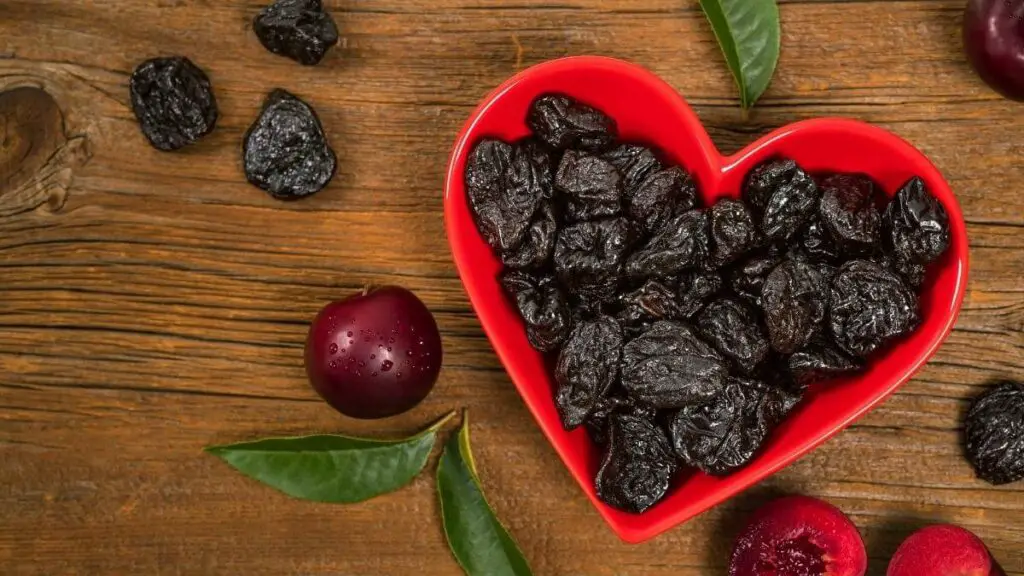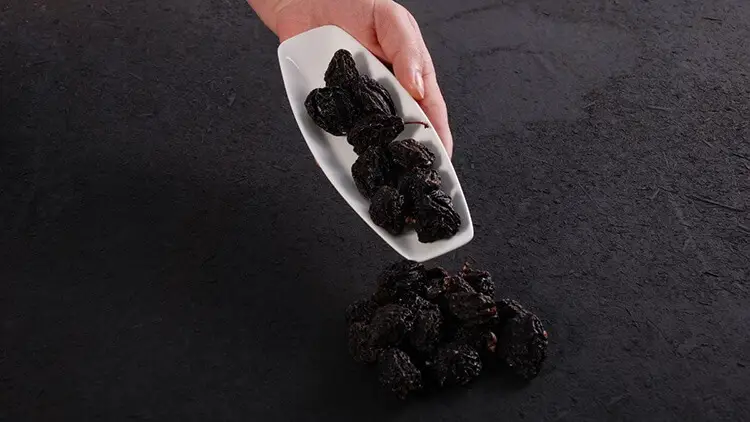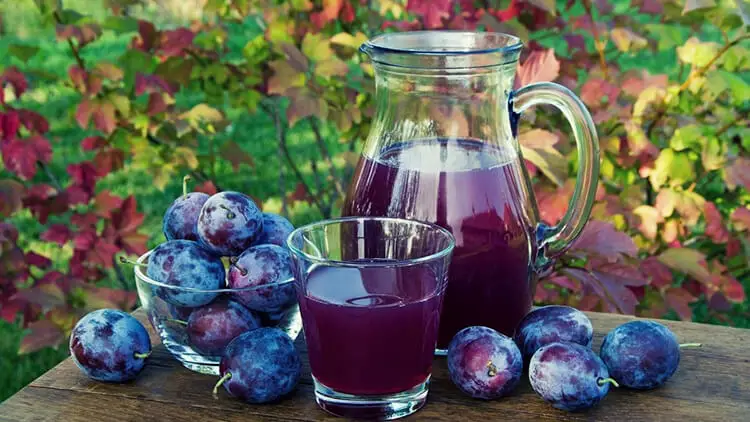If you take a trip to visit someone in a nursing facility, you will often see that the residents or patients get a small bowl of prunes or a half cup prune juice along with other foods for breakfast. Why? They’re not on most families’ dinner table. It’s because prunes are particularly good for seniors.
It turns out that prunes are good food sources for a lot of different nutrients:
- Fiber
- Magnesium
- Potassium
- Iron
- Manganese
- Copper
1 – Prunes are High in Fiber
With ½ cup prunes providing 6.1 grams fiber, you really can’t get much better than that. An apple only has about 4 grams fiber and a pear has between 3 and 4 grams. Berries have less fiber than prunes as well.
Since you need anywhere between 25 and 35 grams a day depending on your body size, that ½ cup of prunes could be providing up to 25% of the fiber you need daily. This is especially important for the elderly for many reasons:
- Pain killers slow down the movement of food through the colon. This ends up causing constipation and very few bowel movements a day.
- Constipation ends up causing hemorrhoids, which are painful and may bleed.
- Constipation causes headaches.
- Constipation causes food stuck inside the GI tract to be altered, creating more toxic and cancer-causing chemicals.
- Constipation makes someone irritable, and even mean-spirited.
- If one serving of prunes are combined with1 tablespoon of fiber, you will get about 11 grams of fiber for the day.
2 – Prunes are a Good Source of Magnesium
Magnesium helps food move through the colon, and magnesium is one of the nutrients that most people are deficient in. Currently there are no lab tests that accurately measure one’s true magnesium levels in the body. However, deficiency symptoms include high blood pressure, anxiety, agitation, panic disorder, low calcium levels, low potassium levels, muscle spasms, muscle tremors, loss of appetite, nausea, and retention of sodium.
When magnesium levels are low, vitamin D levels also can’t rise. Low magnesium is associated with poor insulin sensitivity as well, and a deficiency can contribute to making blood sugar levels erratic. Studies have shown that prunes don’t raise blood sugar, although you might think that they would.
In one study, those who drank prune juice daily had lower blood pressure than those who didn’t.
3 – Prunes are Good Sources of Copper, Manganese, Boron, Iron, and Potassium
These minerals are generally low in the elderly population. When copper and iron are low, the result will be anemia. One-half cup of prune juice provides about 3 mg iron, a good amount if the RDA is only about 9-10 mg per day.
When manganese is low in the body, the skeleton and muscles start aching, which is another common problem of the elderly. In one study, ½ cup prunes eaten a day by postmenopausal women helped prevent worsening bone problems. The women had brittle bones in the study and their condition stopped bone loss. Manganese and boron content of the prunes may have contributed greatly to this effect.
High potassium levels are often a benefit for those who want to be free of heart disease. One small glass of prune juice provides 745 mg of potassium. That’s more than what is found in coconut water, one of the highest food sources for the mineral. Potassium counteracts sodium so if a senior is eating a high sodium diet, the extra potassium may be of benefit.
4 – Prunes Lower Cholesterol
The fiber in prunes sponges up extra cholesterol in the arteries. This was shown in a study in Taiwan where consumption of prune juice. The juice changed the flora of the gut and lowered triglycerides and cholesterol levels significantly. Prunes could be important to decrease the risk of heart attack and stroke.
5 – Prunes Slow Down Aging with Polyphenols
Prune juice is also high in polyphenols which prevent aging. In one study, rats with starting symptoms of dementia that were given prune juice had a better working memory than those given plum powder.
What to Do with Prunes
With all this great information about prunes, you probably can hardly wait to start eating them.
Here are some ways you can incorporate them into your diet:
- Organic Prunes – snip with scissors, place prune snippets in a bowl, and pour boiling water over them to soften.
- Prune Spread – beware of these on the market unless they contain no sugar. Sugar negates the effect of lowering triglycerides and cholesterol. Put prune spread on a cracker or biscuit and eat with cheese.
- Prune Smoothies – use prunes instead of other fruits in your smoothie recipes. Rehydrate the prunes first before adding them to the blender. You’ll need six prunes to give you the health benefits.
- Prune Juice – Please note that the beneficial fiber of prunes has been removed in the process of making prune juice. You are better off making your own prune juice by softening the prunes with boiling hot water for 10 minutes and then adding them to a blender with more water to blend them smooth. Start with ½ pound prunes to 3 cups water for your first few quarts of prune juice.
- Ginger Stewed Prunes – to a small pot, add 1 tablespoon orange zest, freshly squeezed orange juice from one orange, 1 tablespoon dried ginger, and 2 cups prunes. Add 1 cup water to cover the prunes. Stir and cover the pot. Then heat to a slow simmer for 30 minutes. Let them cool and add to Greek yogurt, or even ice cream.
- Prune Pancakes – Add 2/3 cup stewed prunes (blend them) to your regular pancake recipe. You may have to increase your liquid in the recipe to accommodate for the thickness.
- Prune Cakes – Add 2/3 cup diced prunes to any cake recipe. You may have to add a little extra fluid to accommodate for the thickness of the batter.
- Oatmeal Prune Walnut Cookies – Add ½ cup to your usual recipe.
- Prune Added to Your Salads – Add ½ cup diced prunes to any green salad, preferably those with several ingredients.
- Prune Added to Your Pizza – Yes, this is something even recommended by the top dried prune companies, Sunsweet. Add ¾ cup chopped prunes to any pizza you are making. Cover them and your other ingredients with cheese.
- Brownie Disguises – Add ¾ cup chopped prunes to your favorite brownie recipe.
- Prune Cream Cheese Frosting – When making a cake, whip up cream cheese with prunes instead of using sugar. The prunes are sweet enough to give it a good flavor. You can use prune juice or ¼ cup diced prunes to every standard size large package cream cheese.
- Prune Pudding – Soak 1 cup prunes with ½ cup dried cherries, and ½ cup raisins in 3 cups boiling water for 1 hour. In a separate bowl, soak ½ cup almonds in enough water to cover them. Then mix 4 tablespoons arrowroot powder, 2 cups almond milk, and 1 teaspoon vanilla extract into a small pot. Stir. Bring it to a boil and let it thicken. Then add fruits to the custard and serve either warm or cold.



